If you’ve ever walked past a marigold without giving it much thought, you might’ve just snubbed one of the hardest-working plants in the garden.
These fiery blooms aren’t just pretty faces. For centuries, marigolds have been prized not only for their vibrant color, but also for their surprising range of uses, from repelling pests to easing skin troubles. Turns out, there’s a reason our grandparents planted them everywhere.
What Are Marigold Flowers?
Marigold flowers are bright, cheerful blooms that belong to the Tagetes genus, a part of the daisy family. These flowers are known for their striking, golden-yellow, orange and red petals, which make them a favorite in gardens worldwide.
Native to the Americas, marigolds were cultivated by ancient civilizations like the Aztecs, who valued them for their medicinal and spiritual properties. Today, marigolds continue to be celebrated not only for their beauty, but also for their practical benefits. Whether it’s protecting your garden from pests, acting as a natural insect repellent or even offering healing properties for minor skin irritations, these hardy flowers have earned their place as a homesteader’s ally.
What Does the Marigold Smell Like?
If you’ve ever gotten close to a marigold, you know it’s got a scent that’s impossible to ignore. These plants have a strong, distinct fragrance that some people find quite pleasant, while others may find it a bit overwhelming.
The scent is often described as earthy, with a spicy, almost clove-like kick, mixed with a burst of citrus that adds a lively zing. The smell can vary depending on the variety, but it’s generally a bold, pungent aroma. This unique scent also acts as a natural repellent for insects like mosquitoes and aphids.
What Does The Marigold Plant Look Like? Key Characteristics
If you’ve ever wandered through a summer garden and spotted bursts of gold, orange, and fiery red catching the light, chances are you’ve met the marigold. They’re some of the most recognizable flowers around.
🏵️The Marigold Flowers
Depending on the type, marigold blooms can look like fluffy pom-poms or neat little rosettes. The colors range from lemony yellow to burnt orange, often with deep red or bronze accents that almost seem to glow in the sun. Some blooms are small and tidy, others bold and oversized, especially on the tall African varieties.
🍃Marigold Leaves
The leaves of a marigold are finely cut, almost feathery, with deep serrations that give them a fern-like appearance. If you rub them between your fingers, they release a sharp, herbal smell – not unpleasant, just distinctly “green.” The leaves grow in an alternating pattern up the sturdy green stems, which can sometimes carry a purplish tint near the base.
🌱Marigold Roots
Marigolds have a fibrous root system, meaning their roots are thin and spread out, rather than growing deep. This helps them establish quickly and adapt well to different types of soil.
🫘Marigold Flower Seeds
After the flowers bloom and are pollinated, they produce seeds that are typically flat, oval, and brown. These seeds are easy to collect and plant, which is one reason marigolds are so popular for gardeners.
Types Of Marigolds
Not all marigolds are created equal. Some stand tall like golden sentinels, others stay low and bushy, perfect for lining garden beds or keeping pests away from your prized tomatoes. Each variety has its own charm, purpose, and place in your homestead.
1.African Marigolds (Tagetes erecta)
Also known as American marigolds or Aztec marigolds, these are the tallest and boldest of the bunch.
-

Height: 1 to 4 feet
-
Blooms: Large, full and round, like golden pom-poms
-
Colors: Vibrant orange, yellow and gold
-
Perfect for: Making a statement in the back of a flower bed or filling in large sunny areas
African marigolds love the sun and can handle a bit of drought, making them a favorite for tough summer gardens. In Mexico, they’re known as cempasúchil and are deeply tied to tradition, especially during Día de los Muertos.
The name cempasúchil comes from the Nahuatl word cempōhualxōchitl, meaning “twenty flowers” or “flower of many petals.” The Aztecs believed these blooms had sacred, spiritual properties. They used this kind of marigold in rituals, offerings and burials long before Spanish colonization.
According to tradition, the vibrant orange and gold petals are believed to guide the spirits of the dead back home during this sacred time, when families come together to honor and celebrate those who’ve passed on.
2. French Marigolds (Tagetes patula)
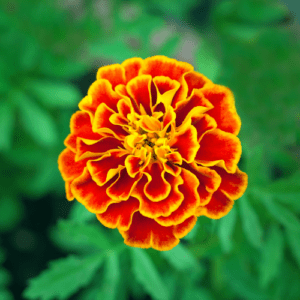
Smaller and more compact, French marigolds bring a splash of elegance and variety.
-
Height: 6 to 18 inches
-
Blooms: Frilled, sometimes bicolored, often red and gold
-
Colors: Red, orange, yellow and even mahogany
-
Perfect for: Borders, raised beds and companion planting
These little charmers are fantastic for keeping pests like aphids, nematodes and even whiteflies at bay. Plant them near your vegetables, and they’ll act like tiny guardians of the garden.
3. Signet Marigolds (Tagetes tenuifolia)
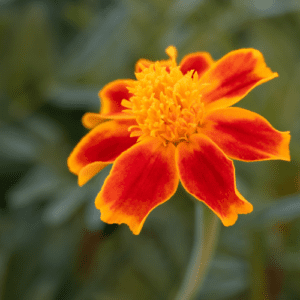
If you’ve never seen signet marigolds before, you’re in for a treat. These are dainty and edible, with a citrusy scent that’s completely different from their more pungent cousins.
-
Height: 6 to 12 inches
-
Blooms: Small and simple—like cheerful little buttons
-
Colors: Yellow, orange, lemon
-
Perfect for: Herb gardens, salads, and adding a delicate touch to paths or containers
The leaves and petals of signet marigolds are edible and often used to brighten up summer salads or baked goods. They’re light, lemony and surprisingly refreshing.
4. Triploid Marigolds (Hybrid between African and French)
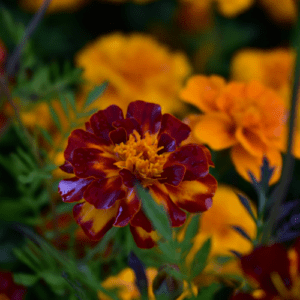
Triploids are like the best of both worlds, crossed between the tall African marigolds and the hardy French ones.
-
Height: 12 to 18 inches
-
Blooms: Large and long-lasting
-
Colors: Bright yellows and oranges
-
Perfect for: Heat-tolerant displays that bloom all season long
The only catch? These hybrids are sterile, so they won’t produce seeds. But they make up for it by blooming non-stop through heat and drought, when others might start to fade.
5. Mexican Mint Marigold (Tagetes lucida)
This one’s a little different.
It’s more herb than flower, often grown for its culinary and medicinal uses.
-
Height: 18 to 30 inches
-
Blooms: Tiny yellow flowers in clusters
-
Flavor: Similar to tarragon, with hints of anise
-
Perfect for: Teas, tinctures and seasoning – especially in Southern gardens where French tarragon struggles to grow
This marigold has a long history of use in traditional remedies and was even considered sacred by the Aztecs.
Related: 15 Medicinal Plants You Need To Start Growing This Spring
How To Plant Marigold Seeds
Planting marigold seeds isn’t just about filling a garden bed. It’s about welcoming a burst of color, fragrance and even a little bit of old-time garden wisdom into your space. If you’re wondering how to grow marigolds from seeds, here’s how you can do that:
🏵️Pick the Perfect Spot:
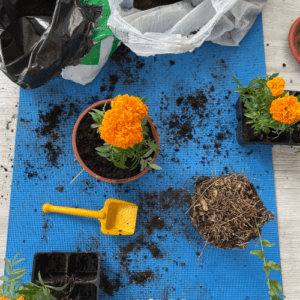
Marigolds aren’t picky about many things, but they do have one non-negotiable request: sunlight. These sunshine-loving flowers need at least 6 hours of direct sun each day to really thrive. Find a sunny corner in your garden or along a walkway where the marigolds can soak up the warmth. They also prefer well-drained soil, so avoid areas where water tends to collect after rain, or else you might drown their roots.
🏵️Prepare the Soil:
Before you toss those seeds into the ground, give your garden bed a little prep work. Loosen the soil with a rake or garden fork, breaking up any clumps and giving the roots room to breathe. If your soil’s a bit heavy or clay-like, mix in some compost or organic matter. Marigolds don’t ask for fancy soil, but they do appreciate a bit of TLC to get their roots started on the right foot.
🏵️Sow the Seeds with Care:
When it’s time to plant, scatter the marigold seeds evenly across the soil, aiming for about 2-3 inches of space between each one if you’re planting in rows. If you’re broadcasting them across a wider area, simply make sure they’re not crowded too closely together. Cover the seeds with a thin layer of soil, no more than a quarter inch deep. Marigold seeds are small, but they’re hardy, so don’t be too gentle. Just a light dusting will do.
🏵️Water Gently:
Now comes the magic: watering. Think of it like giving your seeds their first sip of life. Water the area gently, soaking the soil well without washing the seeds away. Keep the soil consistently moist as the seeds begin to germinate, but don’t drown them. Marigold seeds love moisture, but they also need to breathe. A steady hand and a watering can with a gentle spout are your best tools.
🏵️Thin Out the Seedlings:
Soon, little green shoots will start poking through the soil, stretching toward the sun like eager newcomers. Once they’re a few inches tall, it’s time to thin them out. I know, it feels like you’re saying goodbye to some potential, but trust me, thinning is essential. Space the seedlings about 6-12 inches apart, depending on the variety. This gives each marigold enough room to stretch its roots and show off its full beauty. Plus, it keeps the air flowing around them, which helps prevent disease.
🏵️Tend to Them Like Old Friends:
Marigolds are hardy and fairly low-maintenance, which makes them perfect for anyone looking to add a splash of color without a ton of upkeep. Keep an eye on their water needs, especially during dry spells. Deadhead the spent flowers to encourage more blooms. Marigolds love to keep flowering once they get started. Every time you see them, you’ll remember why you planted them in the first place.
When Should You Plant Marigold Seeds?
Timing your marigold planting just right can make all the difference between a garden full of flowers and one that’s slow to bloom. Here’s what you need to know to get those marigolds in the ground at the perfect time:
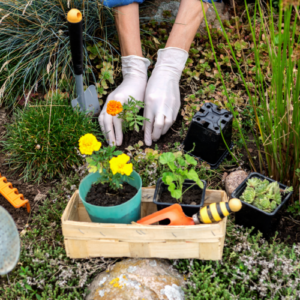
🏵️Starting Indoors: A Head Start for Early Blooms (6-8 Weeks Before Last Frost):
Starting your marigolds indoors about 6-8 weeks before your last expected frost is like getting a jump on the season. Plant your marigold seeds in seed trays or small pots. Keep them in a warm, sunny spot or under grow lights, and make sure the soil stays moist. In a few weeks, you’ll see tiny green shoots pushing through, and by the time the frost danger has passed, you’ll have sturdy seedlings ready to transplant outdoors. Marigolds are quick to grow, so by the time they’re in the ground, they’ll already be off to a strong start.
🏵️Wait for the Last Frost (After the Danger of Frost Has Passed):
If you’re directly sowing marigold seeds in your garden (which is just as fun and satisfying), you’ll want to wait until after the last frost has passed. Marigolds are quite frost-tender, meaning they don’t fare well if they’re exposed to chilly temperatures. Typically, you’ll want to plant marigold seeds outdoors once the soil has warmed up and there’s no more risk of frost. This is usually in mid to late spring, depending on your climate. You can check local gardening guides or ask your neighbors for the right planting window in your area.
🏵️Soil Temperature Matters: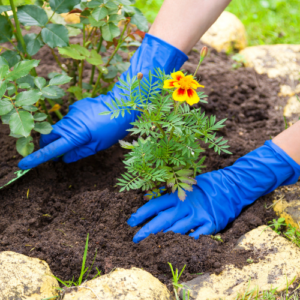
While air temperature is important, marigolds prefer the soil to be warm as well. The soil should be around 60-65°F (15-18°C) before you plant your seeds. You can use a soil thermometer to get an accurate reading, or simply wait until the weather warms up a bit and the ground has dried out from any spring rains.
🏵️Direct Sowing in Summer (If You Missed the Early Window):
If you miss the early spring window, don’t worry. You can still plant marigold seeds in the summer, as long as you’re not in an area with brutal heat or drought conditions. Marigolds thrive in the summer, so sowing them a bit later won’t hinder their growth too much. Just make sure to give them enough water and some shade during the hottest part of the day while they get established.
🏵️A Fall Crop for Some Regions:
And for those of us living in places where frost doesn’t arrive too early, why not try a fall planting? In regions where autumn lingers long and warm, marigold seeds sown late in summer can bloom well into the cooler months, providing a final burst of color as the season shifts.
When should you transplant your marigold seedlings?

Marigolds are warm-season flowers, so they need to be planted after the last frost in your area. This is typically when nighttime temperatures stay consistently above 50°F (10°C). You can check your local last frost date to get a better idea of when it’s safe to transplant marigold seedlings outside.
The marigold seedlings should be at least 2-4 inches tall with several sets of leaves. At this stage, they are strong enough to survive the transplant. If they’re still small and not very sturdy, it’s best to give them more time to grow indoors before moving them outside.
Before transplanting your marigold seedlings directly into the garden, you’ll need to harden them off. This process helps them adjust to the stronger sunlight, wind and fluctuating temperatures of the outdoors. To harden off, start by placing the seedlings outside for 2–3 hours a day in a sheltered spot, gradually increasing the time by an hour each day over the course of a week. Bring them inside at night to protect them from cold drafts.
Wait until the soil has warmed up to at least 60°F (15°C) before transplanting your marigold seedlings. You can test the soil temperature with a soil thermometer. Marigolds thrive in warm soil, and transplanting too early can slow their growth.
When Do Marigolds Bloom?
Marigolds are like the dependable friends of the garden. Once they get going, they bloom their hearts out all season long. But when exactly they bloom depends on how and when you plant them.
Plant marigold seeds after the last frost, and they’ll sprout quickly. Usually within 5 to 7 days if the soil is warm. Give them 45 to 60 days, and they’ll start to bloom, right when the rest of the garden is waking up.
So if you sow seeds in early to mid-spring, you can expect flowers by late spring to early summer, and they’ll keep on going all the way until the first frost in fall.
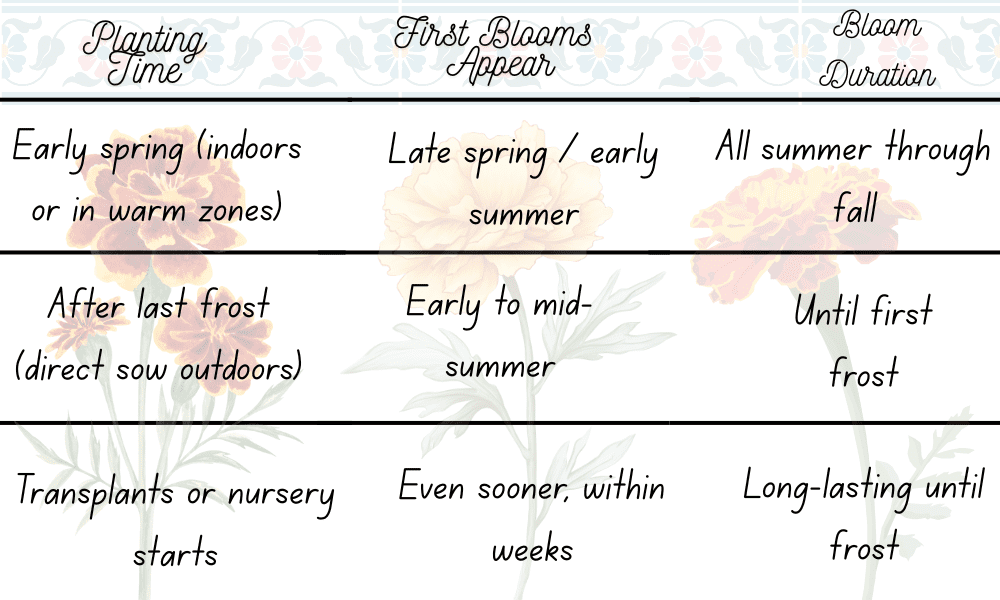
What Makes Marigolds Bloom Better?
To keep marigolds blooming their best:
- Deadhead regularly – remove spent flowers to encourage more blooms
-
Full sun – they love sunshine and need 6+ hours a day
-
Well-drained soil – they don’t like soggy roots
-
Not too much fertilizer – too much nitrogen = more leaves, fewer flowers
Marigolds in Your Vegetable Garden – What Can It Do?
Marigolds in the vegetable garden are like the unsung heroes. Showing up, doing the dirty work and brightening things up without asking for much in return. But their contributions go far beyond just adding a splash of color.
If you’ve ever wondered, “What can marigolds really do for my veggies?”, here’s the scoop:
🏵️Natural Pest Control – Your Garden’s Bodyguard
Marigolds are like the garden’s natural security system. The secret? They produce a strong, musky scent that many pests, like aphids, whiteflies, and even nematodes, find totally unappealing. African marigolds (Tagetes erecta) are especially good at keeping those pesky bugs away.
But it’s not just the smell. Marigolds also attract beneficial insects like ladybugs, lacewings and hoverflies, which are the natural predators of many garden pests. So, while marigolds are fending off the bad guys, they’re also rolling out the welcome mat for the good guys. One-two punch for your vegetable patch.
And marigolds are just the beginning. I’ve found that teaming them up with other natural defenders makes the garden even more resilient. These plants don’t just look good, they work hard. If you’re thinking of giving your garden an all-natural defense upgrade, there’s a kit I came across that includes non-GMO, anti-pest powerhouses like calendula, yarrow and many more. It also includes a guide that teaches you everything you need to know, from planting them to how you can use them around your garden and homestead. It’s a great way to build a garden that practically takes care of itself.
🏵️Attracting Pollinators – Bringing the Buzz to Your Garden
While marigolds are mostly about keeping pests in check, they’re also helpful for drawing in pollinators. Bees absolutely love marigolds and will flock to their bright, cheery blooms, giving your vegetables a much-needed pollination boost. More pollinators = more fruits and veggies!
🏵️Soil Health – Keeping Things in Balance
If you’re thinking long-term, marigolds can help balance your garden’s soil. Their roots exude compounds that can help reduce the populations of harmful nematodes in the soil, improving the soil structure and creating a healthier growing environment for your plants. This makes them a great choice for crop rotation or for prepping soil for the next growing season.
🏵️Weed Control – Nature’s Mulch
In addition to their pest-fighting skills, marigolds can also help suppress weed growth. Their low-growing foliage forms a tight mat that blocks weeds from taking root, giving your vegetables a better chance to grow without competition for nutrients.
🏵️Companion Planting – Helping Your Veggies Thrive
Marigolds aren’t just hanging out for the company. They’re making a real difference to the health of your veggies. By planting marigolds alongside crops like tomatoes, peppers and beans, you can improve the overall health of the garden. The marigolds’ roots even help suppress soil-borne pests like nematodes, which can damage plant roots and slow down growth.
Some gardeners swear by planting marigolds near beans to keep aphids at bay, and around tomatoes to promote stronger growth. So, in a way, marigolds act as little bodyguards for your veggie plants, making sure they’re safe while they grow tall and healthy.
Companion Planting with Marigolds: What Plants Benefit from Them?
Marigolds are not only beautiful and easy to grow, but they also have numerous benefits when used as companion plants. They release a strong scent that can confuse or deter pests, making them a great natural pest control option. Furthermore, their roots emit certain compounds that repel harmful nematodes from attacking nearby plants.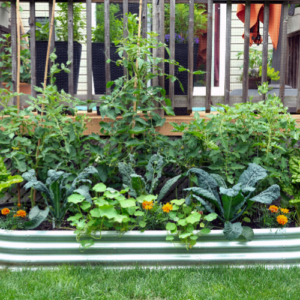
So which plants benefit the most from having marigolds as companions? Let’s take a closer look at some of the top choices:
- Tomatoes: These two plants have been famously known as perfect companions for each other. Marigolds attract pollinators such as bees and butterflies, which help increase tomato yield. They also contain thiophenes – naturally occurring chemicals that can protect tomatoes from root-knot nematodes.
- Beans: As legumes, beans have a symbiotic relationship with nitrogen-fixing bacteria in the soil that helps them absorb nitrogen from the air and convert it into usable forms for growth. Marigolds are known to attract these beneficial bacteria, providing an extra boost of nitrogen to nearby bean plants.
- Cucumbers: Cucumbers are prone to diseases such as downy mildew and cucumber beetles. Planting marigolds near cucumbers can act as a deterrent for these pests while also adding beauty to your garden with their bright yellow and orange flowers.
- Brassicas: This family includes vegetables such as broccoli, cauliflower, cabbage, and kale – all susceptible to attack by cabbage worms and aphids. Interplanting marigolds among brassicas has been shown to reduce pest damage significantly.
- Peppers: Similar to tomatoes, peppers also benefit from the pollination that marigolds attract. Additionally, marigolds can help repel pests such as pepper maggots and nematodes that can damage the roots.
In addition to these plants, marigolds also make great companions for herbs like basil and oregano, as well as other flowers like zinnias and sunflowers. However, it’s important to note that not all plants thrive when planted with marigolds. Avoid planting them near melons or potatoes, as they may hinder their growth.
If you’re looking to really dig into the ins and outs of pairing plants like this, there’s a resource I came across that’s packed with strategies just like these – smart companion planting techniques that can help you grow twice as much food on the same piece of land. Whether you’re working with a backyard garden or a full-on homestead, knowing which plants work best together can make a world of difference in how much you harvest.
Pest Repellent Properties of Marigolds and How They Work
Marigolds contain natural compounds that can help keep pesky insects and animals away from your garden, making them a must-have for any homesteader.
One of the main ways marigolds work as a pest repellent is through their strong scent. The pungent smell of marigolds is unpleasant to many insects and animals, causing them to stay away from the plants. This is especially effective against pests like aphids, whiteflies, and other common garden bugs.
In addition to their scent, marigolds also produce a chemical called limonene, which acts as a natural insecticide. This compound is toxic to many pests including mosquitoes, gnats, and flies. When these insects come into contact with limonene in the air or on the plant’s leaves, it disrupts their nervous system and can even kill them.
Related: Mosquito and Fly Repellent Plants You Need To Grow For Summer
The roots also release a chemical called alpha-terthienyl, which has been found to repel nematodes – microscopic worms that feed on plant roots and cause damage to crops.
It’s important to note that while marigolds do have strong pest repellent properties, they are not 100% effective on their own. It’s still necessary for homesteaders to practice proper gardening techniques such as crop rotation and regular pest monitoring to ensure a healthy and thriving garden.
Attracting Beneficial Pollinators with Marigolds
When it comes to homesteading, creating a self-sustaining ecosystem is key. And one of the most important components of any ecosystem is pollinators. These tiny creatures play a crucial role in the growth and reproduction of plants, making them essential for a successful homestead.
While many people may think of bees as the main pollinators, there are actually a variety of beneficial pollinators that can be attracted to your backyard. One way to do so is by planting marigolds.
Marigolds serve as an excellent source of nectar and pollen for pollinators. The strong scent they emmit helps attract various types of pollinating insects, such as butterflies, bees, and even beetles. These insects are naturally drawn to the sweet-smelling nectar produced by marigold flowers and will keep coming back for more. This continuous visitation ensures that your plants have a higher chance of being successfully pollinated.
One important thing to note when planting marigolds for attracting beneficial pollinators is choosing the right variety. French Marigolds (Tagetes patula), African Marigolds (Tagetes erecta), and Signet Marigolds (Tagetes tenuifolia) are some of the best options for attracting pollinators due to their strong scent and high nectar content.
Tips for Growing Marigolds in Your Homestead Backyard
If you’re looking to grow marigolds in your homestead backyard, here are some tips to help you get started.
- Choose the Right Location: Marigolds thrive in full sun, so make sure to choose a location in your backyard with plenty of direct sunlight. They also prefer well-draining soil, so if your soil is heavy and retains water, consider adding some organic matter like compost or peat moss to improve drainage.

- Start from Seeds: While marigolds can be grown from cuttings or transplants, starting them from seeds is the most cost-effective option for homesteaders. You can either start the seeds indoors 4-6 weeks before the last frost date or sow them directly into the ground after all danger of frost has passed.
- Planting and Spacing: When planting marigold seeds, sprinkle them on top of the soil and lightly cover them with a thin layer of soil. Make sure to space them at least 6 inches apart as they can grow quite large and need room for proper air circulation.
- Watering: Marigolds require regular watering as they do not tolerate drought well. However, be careful not to overwater as this can lead to root rot and other fungal diseases. A good rule of thumb is to water deeply once a week rather than shallowly every day.
- Fertilizing: Marigolds are relatively low-maintenance plants but benefit from occasional fertilization during their growing season. Use an all-purpose fertilizer once a month to give them an extra boost.
- Weed Control: Keep weeds at bay by regularly weeding around your marigold plants. This will not only keep your garden looking neat but also prevent competition for resources.
- Deadheading: To encourage more blooms and a longer blooming period, it is essential to deadhead your marigolds regularly. This involves removing the faded or wilted flowers by pinching them off at their base.
- Mulching: Consider adding a layer of mulch around your marigold plants to help retain moisture and suppress weed growth. Organic options like straw, grass clippings, or shredded leaves work best for marigolds.
Related: This Is Why You Should Grow Living Mulch In Your Garden
Incorporating marigolds into your garden is a wise choice for any homesteader looking to improve their plant’s health and deter pesky pests in a natural way. By choosing the right companion plants for your marigold patch, you can create a thriving ecosystem in your backyard while enjoying the beautiful blooms of this versatile flower.
Marigold Uses in DIY Projects
If you’re into DIY projects, marigolds are the perfect plant to add some natural charm to your creations. Whether you’re crafting homemade beauty products, designing unique decorations or making useful gardening tools, marigolds can be your go-to ingredient. Here’s a breakdown of some creative DIY ideas you can try using marigolds:
Using Marigolds as a Natural Mosquito Repellent
The active ingredient in marigolds that repels mosquitoes is called pyrethrum. Pyrethrum is a compound found in the flower’s petals which acts as a powerful insecticide. It works by attacking the nervous system of insects, including mosquitoes, causing them to become paralyzed and eventually die. This makes marigolds an effective and natural alternative to chemical-based mosquito repellents.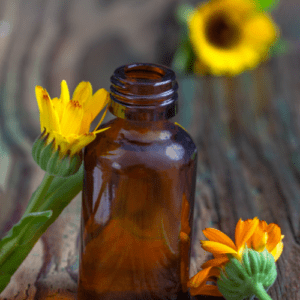
To use marigolds as a natural mosquito repellent, you can simply plant them around your backyard or outdoor living space. Their strong scent will help keep mosquitoes at bay while adding a pop of color to your garden. Marigolds are easy to grow and require minimal maintenance, making them an ideal addition to any homesteader’s backyard.
Another way to utilize marigolds as a natural mosquito repellent is by creating a homemade spray using their essential oils. To make this spray, you will need:
– 2 cups of distilled water
– 1 cup of witch hazel
– 10 drops of marigold essential oil
Mix all the ingredients together in a spray bottle and shake well before each use. Then, simply spritz the solution onto your skin before heading outdoors or around areas where mosquitoes tend to congregate.
You can also create small bouquets of fresh marigold flowers and place them on tables or hang them near doorways and windows to deter mosquitoes from entering your home.
Marigold Dye for Natural Fabrics
Marigolds are wonderful for creating a natural dye that adds a vibrant golden hue to fabric. This DIY project is perfect for creating your own hand-dyed scarves, tea towels or wall hangings.
-
What you need: Fresh marigold petals, a pot for boiling, a strainer and a fabric item (like cotton or linen).
-
Steps: Boil the marigold petals in water for about 30 minutes to extract the color. Strain the petals out and add your fabric to the dye pot. Let it simmer for about 15–20 minutes or until you’re happy with the color. Rinse the fabric with cold water, let it dry and voilà! A beautiful, sunny-colored fabric made naturally from marigolds.
Marigold Potpourri
Create a sweet-smelling potpourri using marigold petals to bring a burst of fragrance into your home. The dried petals not only smell lovely but also bring a cheerful pop of color.
-
What you need: Dried marigold petals, other dried flowers (like lavender, roses, or rosemary), dried herbs (cinnamon sticks, cloves), and essential oils.
-
Steps: Mix the marigold petals with other dried flowers and herbs. Add a few drops of your favorite essential oil (lavender, rose, or cinnamon are great options). Let the mixture sit for a week or so to allow the scents to blend, then display it in a decorative bowl or small sachets around your home.
Marigold-Infused Soap
For a DIY beauty project, you can create your own marigold-infused soap. It’s a wonderful gift idea or personal treat for your skin.
-
What you need: A soap base (glycerin or shea butter), dried marigold petals, soap mold and essential oils (optional).
-
Steps: Melt the soap base in a microwave or double boiler. Stir in dried marigold petals and a few drops of essential oil (like lavender or tea tree). Pour the melted mixture into a soap mold and let it harden for a few hours. Once it’s set, pop it out and you have a beautifully floral soap bar, perfect for using in the shower or giving as a gift.
Related: If You Have This Plant in Your Backyard, You Will Never Run Out of Soap
Medicinal Uses of Marigold and Benefits
Marigolds have been cherished for centuries due to their medicinal properties. From soothing skin irritations to supporting immune health, marigolds are a powerful, all-natural remedy that’s easy to incorporate into your life.
Marigold Tea for Relaxation
If you’re into DIY wellness, marigold tea is a calming, easy-to-make beverage that helps with relaxation and digestive health.
-
What you need: Fresh or dried marigold petals, hot water and honey or lemon (optional).
-
Steps: Simply steep a teaspoon of marigold petals in hot water for about 5–10 minutes, then strain and enjoy. You can add a bit of honey or lemon to taste. It’s a simple, soothing tea that’s perfect for winding down after a long day.
Marigold-Infused Oil for Skin Care
Making your own marigold-infused oil is an easy DIY project that brings the power of marigolds into your skincare routine. Marigold is known for its healing properties – perfect for soothing dry skin, cuts, and irritation.
-
What you need: Dried marigold petals (fresh petals can work too, but dried is better to avoid mold), a carrier oil (like olive or coconut oil), and a glass jar.
-
Steps: Fill the jar halfway with dried petals, then cover them with your carrier oil. Seal the jar tightly and let it sit in a warm, sunny spot for about 2–3 weeks, shaking it gently every few days. Afterward, strain out the petals and use the infused oil on your skin.
You can use this oil for everything from making moisturizers and lip balms to soothing creams and lotions!
Marigold Salve for Skin Healing
Marigold salve can be made with the same marigold-infused oil, and it’s a great DIY project for treating minor skin irritations like scrapes, insect bites and rashes.
What you need: Marigold-infused oil, beeswax (about 1 ounce for every 8 ounces of oil), and a container to store the salve.
Steps: Melt the beeswax in a double boiler, then add the marigold-infused oil and stir well. Once it’s fully mixed, pour the salve into small containers and allow it to cool and harden. Once it’s solid, your homemade marigold salve is ready to soothe skin irritations.
This salve is perfect for dry skin, minor wounds, and even insect bites!
This is one of the remedies I found from Nicole Apelian’s recipes. She has a book that contains over 200 powerful, all-natural remedies made from usual things we all have in our gardens or kitchens. I also learned how to make my very own all-natural herbal toothpaste, a facial cream that has an even more powerful effect than botox, and many more simple recipes that actually work. I’ve already swapped out half the stuff in my medicine cabinet with what I’ve made from her guide.
Marigold Facial Steam for Relaxation
A marigold facial steam is a soothing way to cleanse and refresh your skin. It can help to open your pores and provide a mild anti-inflammatory effect, great for reducing redness or irritation.
What you need: Dried marigold petals, a bowl of hot water, and a towel.
Steps: Boil water and pour it into a large bowl. Add a handful of dried marigold petals to the water. Drape the towel over your head and the bowl to trap the steam, then lean over the bowl for 10-15 minutes. The steam will help to purify your skin while the marigold’s soothing properties work their magic.
Use this steam as a part of your weekly skincare routine for a refreshing, calming experience!
Marigold Tincture for Digestive Aid
A marigold tincture is a concentrated, alcohol-based extract of the plant. It’s a great way to harness marigold’s anti-inflammatory properties to support digestion or soothe minor respiratory issues.
What you need: Fresh or dried marigold flowers, high-proof alcohol (like vodka or brandy), and a glass jar.
Steps: Fill a jar halfway with marigold flowers, then pour alcohol over them to fully submerge the flowers. Seal the jar and store it in a cool, dark place for 2-4 weeks. Shake it daily. After the steeping period, strain out the flowers and store the tincture in a dropper bottle. Take a few drops in water or tea as needed to help with digestion or mild respiratory discomfort.
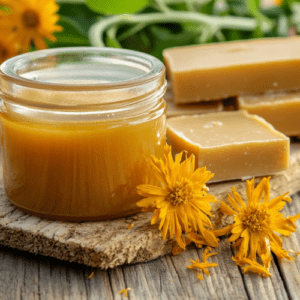
This tincture can be a natural remedy for minor digestive issues, and it’s easy to add to your wellness routine!
Marigold-Infused Honey for Sore Throat Relief
Marigold-infused honey is a delicious way to use marigold for its medicinal benefits. It’s especially soothing for a sore throat or cough, and it makes a great natural sweetener for tea.
What you need: Fresh or dried marigold flowers, honey (preferably raw or unfiltered) and a glass jar.
Steps: Fill the jar halfway with marigold flowers, then pour honey over them, ensuring the flowers are fully covered. Seal the jar and allow it to sit in a warm place for 1-2 weeks, stirring occasionally. After the infusion period, strain out the flowers, and your marigold-infused honey is ready to use.
Use it in your tea or take a spoonful to soothe a sore throat or cough!
How to Preserve Marigold Seeds
If you’re wondering how to save your marigold seeds for next year, it is a simple and rewarding process. Marigolds are easy to grow from saved seeds, and you can ensure a healthy supply of flowers for future seasons. Here’s how you can save your marigold seeds:
Marigolds produce plenty of seeds, and collecting them is an easy way to keep your garden going year after year.
You only need some healthy marigold flowers, a paper bag or envelope and a cool, dry storage place.
Steps For Preserving Your Marigold Seeds:
Wait for the Flowers to Dry:
After your marigold flowers have bloomed and started to fade, allow the flower heads to fully mature on the plant. The petals will dry up, and the seed heads will turn brown. This usually happens towards the end of the growing season, just before the first frost. Do not cut them off too early, as immature seeds won’t be viable.
Harvest the Seed Heads:
Once the seed heads are dry and brown, use your fingers to gently remove the seeds from the flower head. You’ll find small, brownish seeds tucked inside the dried flower head. These seeds are typically long and narrow, with a slightly curved shape.
Separate the Seeds:
Gently separate the seeds from the dried flower. You may need to remove any small plant debris or petals that are still attached. Be sure to handle them carefully so that they don’t break or become damaged.
Dry the Seeds: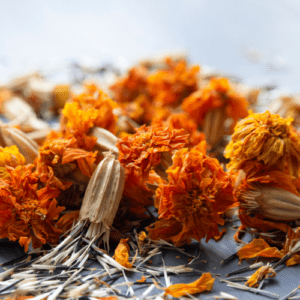
If the seeds feel damp, spread them out in a single layer on a piece of paper or a paper towel and let them dry for a few more days in a warm, dry place. This is important to prevent mold and rot during storage.
Store the Seeds:
Once completely dry, store your seeds in a paper envelope or a small paper bag. Avoid plastic containers, as they can trap moisture and cause the seeds to mold. Label the envelope with the date and the type of marigold, if you have different varieties. Keep the seeds in a cool, dry place, such as a drawer or a box in your garage, out of direct sunlight.
Plant Next Season:
The seeds will be ready to plant next season! With your saved seeds, you’ll have vibrant blooms in your garden once again.
How To Dry Marigold
Drying marigolds lets you preserve their color, fragrance, and all those handy medicinal benefits. Here’s how I do it:
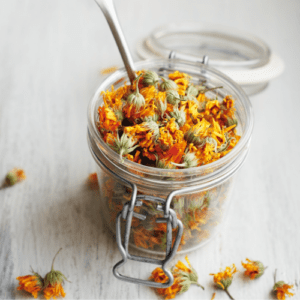
I usually wait for a dry day, ideally in the morning after the dew has evaporated. That’s when the marigolds are at their peak, full of color and scent. I snip off the heads, leaving a short portion of stem for hanging if I want to go that route.
Air Drying
My favorite method is air drying. I bunch the marigolds together and tie them with string, then hang them upside down in a cool, dry place. A pantry or barn works well, as long as there’s good airflow. In about 1-2 weeks, the petals should be dry and crisp to the touch.
Drying Rack
If you don’t want to bother with hanging them, you can lay the flowers flat on a drying rack or screen. I spread them out in a single layer and leave them for about 7-10 days. Just make sure the spot is dry and well-ventilated.
Dehydrator
If you’re short on time, a dehydrator does the trick. Set it to a low temperature (95-105°F) and let the flowers dry for 4-6 hours, checking occasionally.
Once they’re fully dried, I store the marigolds in airtight containers like glass jars, away from light to keep them fresh. They’re perfect for making tea, salves, or just adding a pop of color to homemade remedies.
Marigolds are a versatile plant that goes beyond adding beauty to your backyard. Incorporating them into natural remedies and using them as decorative elements is a great way to make the most out of this wonderful plant. So why not add some marigolds to your backyard today?
Frequently Asked Questions About Marigolds
Can you plant marigolds in the fall?
While marigolds are generally spring and summer bloomers, you can plant them in the fall, but their growing season will be shorter before the first frost. If you live in a mild climate with a warm fall, marigolds may continue blooming well into the season. However, in areas with cold winters, marigolds are usually grown as annuals and won’t survive through the fall unless they are brought inside or protected from frost.
Do marigolds need light to germinate?
Yes, marigold seeds do need light to germinate. Lightly press the seeds into the soil or sprinkle them on the surface and gently water them. You don’t need to bury them too deeply, as they require light to sprout. Keeping them in a warm, sunny location will encourage faster germination.
Can marigolds survive winter?
Marigolds are not winter-hardy in most climates, so they are not considered seeds you should plant in winter. They are annuals, which means they only live for one growing season. Once the first frost hits, marigolds will die. If you want to keep them over the winter, you can try bringing them indoors or taking cuttings to root indoors until the next growing season. In milder climates, marigolds might survive winter, but they usually need to be treated as annuals.
Do marigolds reseed themselves?
Yes, marigolds are self-seeding plants! If left in the garden, they will drop their seeds when the flowers fade and will often sprout in the same area the following spring. This natural process is especially common with African marigolds. If you want to control where they grow, you may need to deadhead (remove spent flowers) or collect the seeds.
Why are my marigolds dying?
There could be several reasons why your marigolds are struggling:
-
Overwatering or poor drainage can lead to root rot.
-
Pests like aphids, caterpillars, or snails can damage the plants.
-
Too much shade: Marigolds love the sun, so they may not thrive if they don’t get enough light.
-
Nutrient deficiencies or disease (like powdery mildew) can also cause them to decline. Make sure your plants are getting the right nutrients and are in healthy, well-drained soil.
Why aren’t my marigolds flowering?
If your marigolds aren’t flowering, it could be due to:
-
Insufficient sunlight: Marigolds need at least 6 hours of full sun daily.
-
Nutrient imbalance: Excessive nitrogen from fertilizers can promote leafy growth at the expense of flowers. Make sure to use a balanced fertilizer.
-
Overcrowding: Too many plants in one area can stunt growth and flowering. Ensure your marigolds have enough space to grow.
-
Pest or disease damage: Check for pests like aphids or diseases like powdery mildew, which can prevent blooming.
Do marigolds like coffee grounds?
Yes, marigolds love coffee grounds! Coffee grounds are rich in nitrogen, which marigolds enjoy. They can be sprinkled on the soil or added to compost. However, it’s best to mix the grounds into the soil or compost pile instead of leaving them in large, thick clumps, as the acidity may cause problems if concentrated.
What should you not plant with marigolds?
While marigolds are generally good companions in the garden, there are a few plants they don’t get along with:
-
Fennel: Marigolds and fennel don’t play well together and may stunt each other’s growth.
-
Mint: Mint can overpower marigolds with its aggressive growth.
-
Cabbage family: Avoid planting marigolds with members of the cabbage family, like broccoli or cauliflower, as they may not thrive together.
Are marigolds poisonous for chicken?
No, marigolds are not toxic to chickens. In fact, chickens may enjoy pecking at marigold petals. However, like with any plant, it’s always a good idea to monitor your chickens to ensure they’re not consuming large amounts of any plant, which could potentially cause digestive issues.
Do rabbits eat marigold?
Rabbits are generally not fond of marigolds due to their strong scent and bitter taste. While they might nibble on the leaves or flowers if food is scarce, marigolds are typically rabbit-resistant compared to other garden plants. However, no plant is entirely rabbit-proof.
Are marigolds deer resistant?
Yes, marigolds are deer-resistant. Deer generally dislike the strong scent of marigolds, which makes them less likely to munch on these flowers. However, in areas with high deer populations, it’s still possible that they might nibble on your marigolds if food is scarce.
The Forager’s Guide To Wild Foods: Book Review

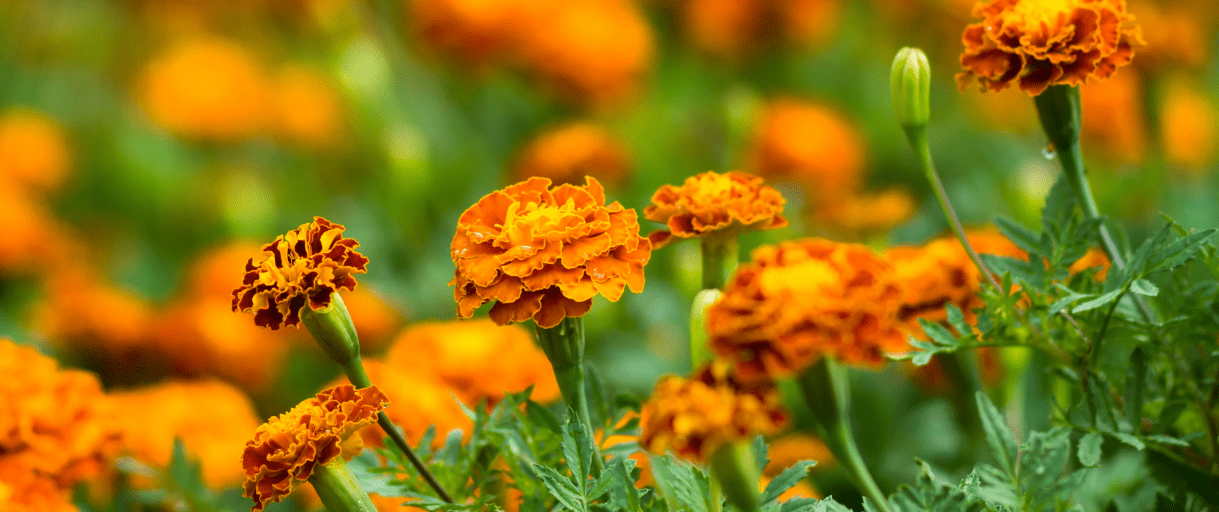

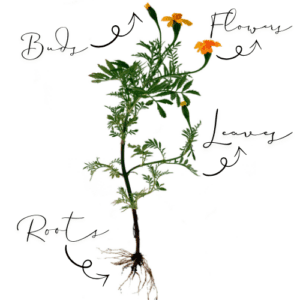
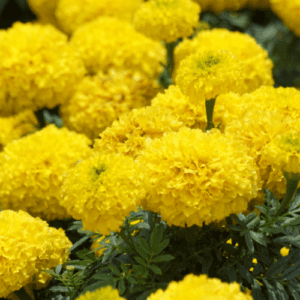
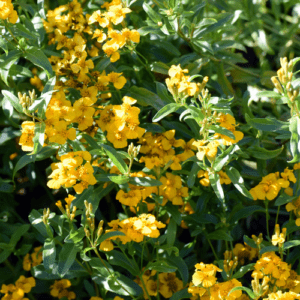
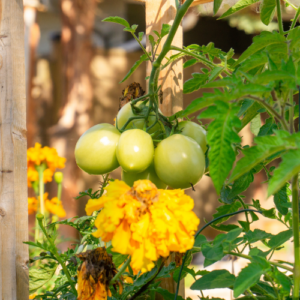
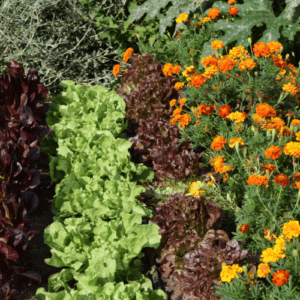
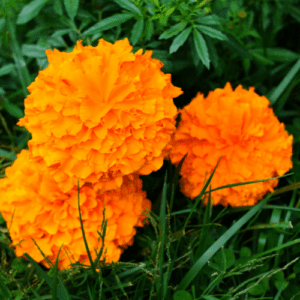
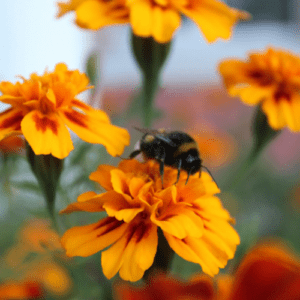
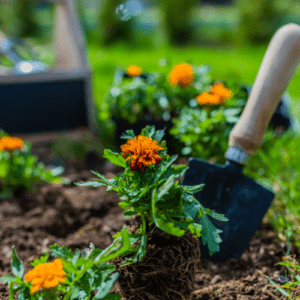
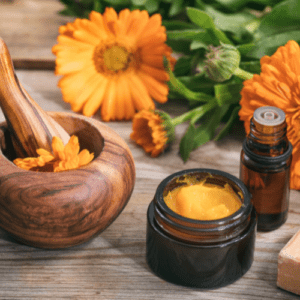
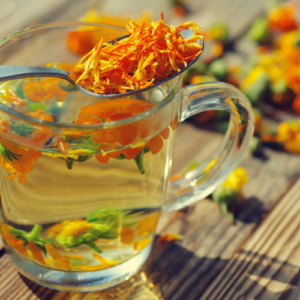
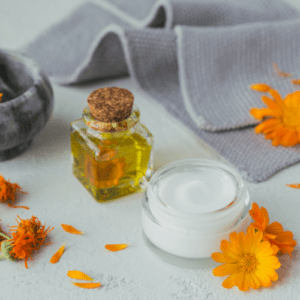






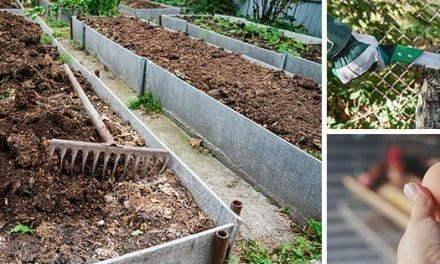







I love how marigolds are so much more than just pretty flowers. They’re super useful too, perfect for keeping pests away, very useful for skin and adding some color to the garden. This is soo amazing dear.